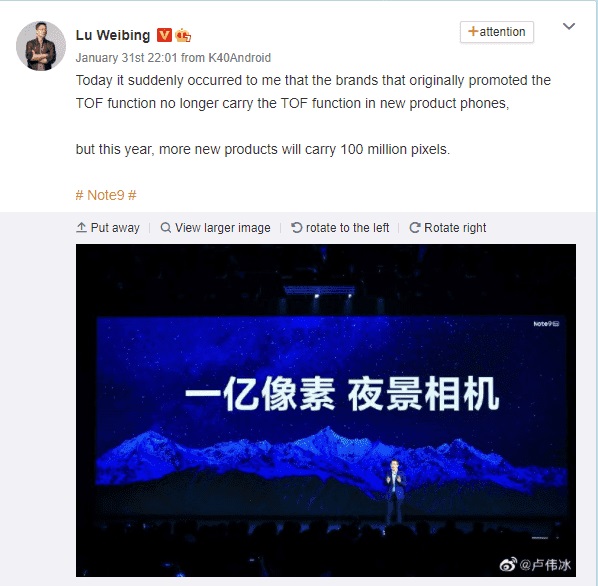Did Xiaomi’s GM call phones with 108MP cameras a gimmick?
Change is the only constant in the technology industry. In a bid to outbid the competition or to become an industry leader, constant innovation and introduction of new features at a rapid pace have become an integral part of the industry. This is probably the reason why a feature or piece of tech that became a necessity in all phones in the last couple of years might have vanished in thin air with the dawn of 2021.
Xiaomi’s General Manager Liu Weibing has highlighted the same in his post on Weibo and justified the reason why none of Xiaomi’s phones came with a ToF sensor.
Taking a dig at other brands that had promoted ToF sensors heavily during the launch events and otherwise, he said: “Today it suddenly occurred to me that brands that originally promoted the TOF function no longer carry the TOF function in new products phones.”

However, he also subtly added that “but this year more new products will carry 100 million pixels,” suggesting that 108mp sensor will be a feature that will get democratized and will be seen in more phones than ever before.
- Best camera phone 2021: our picks for the best smartphone cameras right now
- Xiaomi's under-display cameras are coming to phones in 2021
- Oppo’s invisible ‘under display’ camera just made notches and cutouts irrelevant
Gimmicks over features
While the ToF or Time of Flight sensor was hailed as the next big thing in the smartphone industry, brands that introduced it as a feature were seen going gaga over its use for AR and 3D imaging. According to an explanation found on Samsung’s website, “ToF Camera is used with Live focus video and Quick Measure, letting you add more creative flair and get information in a way you've never seen before.” And that it allows you to “blur out the background in real-time” or makes your camera act “as a 3D camera, judging width, height, area, volume, and more when you put an object in frame.”
To put in simpler terms the ToF sensor helps offer better depth in images or videos and allows you to take measurements of an object.
However, Liu Weibing has always been critical of this feature and has called it a mere gimmick. He has even suggested that this feature has just been added to lure users in spending more money on the phones and has stated this as a useless feature. Interestingly he voiced these thoughts back in 2019 when Android smartphones with ToF sensors were expected to amass over 20 million shipments.
In hindsight, which is normally the safest way to look at things, his opinion does hold ground. Quite a few brands including Huawei, Honor, Samsung etc. that were aggressively marketing ToF sensors as a breakthrough feature have now gradually stopped using it altogether. We do have Samsung’s flagship Note 20 series rocking these sensors but not many devices in the affordable price bracket come equipped with this additional sensor.
His post also suggests that smartphone makers this year will focus on the massive 108-megapixel sensor and quite a few devices will come with this massive sensor. This means an obvious megapixel war and an increase in the pricing of smartphones.
Megapixel war?
We already have smartphones with 48mp and 64mp sensors going mainstream and Samsung is rumoured to be working on 150, 200 and even 600mp sensors. This is at a time when Google and Apple are still using an array of 12- or 13-mp camera sensors and producing amazing results. Both iPhones and Pixel phones are considered to be best camera phones by a fair margin thanks to the software prowess these companies possess and are not solely dependent on higher megapixel count.
Xiaomi itself has introduced the Mi 10i with a 108mp camera already in markets outside China (read India) and the Snapdragon 888-toting Mi 11 is heading for a global launch.
Apart from these Xiaomi also has a slew of devices ready with the 108-megapixel camera to be launched in its home and overseas markets. So, is Xiaomi’s GM hinting that even these are a gimmick?
Remember, a great photo is still a result of photographers’ keen eye to capture the moment, aided by the light and placement of the object. The higher megapixel count doesn’t guarantee a great photograph.
Though a bigger sensor does have a few benefits and better low light photography is one of them. A larger sensor will collect more data compared to a smaller sensor, however, a bigger sensor will not result in a sharper low-light image automatically. It will still need software optimization to process the data provided by the sensor to produce an excellent low-light photograph.
So next time you’re in the market to shop for a new phone, not falling for the gimmicks will help you save a lot of money.
Via- GizChina
Want to know about the latest happenings in tech? Follow TechRadar India on Twitter, Facebook and Instagram!
from TechRadar - All the latest technology news visit

Comments
Post a Comment